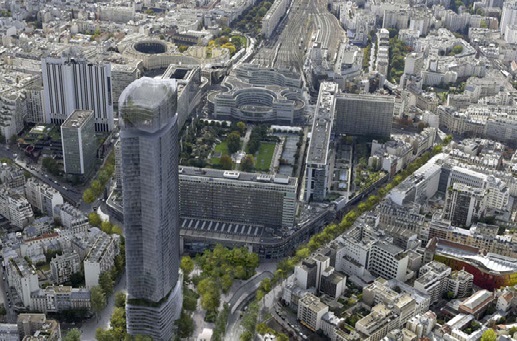RSHP Montparnasse Masterplan competition win

|
| Image courtesy of Rogers Stirk Harbour + Partners (RSHP). |
On July 12, 2019, Rogers Stirk Harbour + Partners (RSHP) announced it had won a competition organised by the Ville de Paris for the Montparnasse Masterplan, on the left bank of the river Seine in Paris.
The project aimed to simplify how the site is read, how it is perceived and how people move and interact within it, while also recognising and reinforcing its unique qualities. RSHP aimed to apply a global vision to this transformation by instilling more dynamism and diversity to this pivotal quarter of Paris.
The London-based international architect wanted to celebrate the intrinsic qualities of ‘place’, its vocation as a cultural and transport hub while also radically transforming its image. It proposed delivering a more lively, accessible and sustainable neighbourhood. its objective was to open the existing outdated and essentially introverted and closed complex of the Maine-Montparnasse Tour Real Estate Development (or EITMM), rendering it more permeable.
RSHP identified its ‘natural’ flows and desire lines to deliver direct, short, simple and legible routes across the site. The road access is rationalised in favour of the pedestrian and bicycle access as well as public transport. Reflecting the desires of the majority of the local residents who were consulted, RSHP proposed a new ‘green’ neighbourhood, including the planting of an ‘urban forest’, composed of 4,000 new trees and 10,000 m² of green space. The image of the site which was dominated by hardscape, roads and parking would be radically changed.
RSHP also aimed to deliver an ambitious sustainable strategy, an exemplary low-carbon district in Maine Montparnasse. The new neighbourhood will be carefully adapted to the challenges of climate change, incorporate bioclimatic design, the management of the wind and heat island effects, rooftop urban agriculture, cogeneration and shared energy systems, improved biodiversity, components of a circular economy on-site and, notably, a large proportion of conserved and recycled buildings and structures (thereby reducing the amount of demolition). By adding, but also by removing elements, in a targeted manner the architects proposed a development on a human scale, better integrated within the urban fabric of the city, a resilient neighbourhood that can evolve with time and house a dynamic diversity of uses through a gradual, intelligent and pragmatic phasing strategy.
For this vision to become a reality, RSHP is committed to engaging with all stakeholders and will be entering into a process of dialogue – the purpose of which will be to deliver a project that reflects a broad consensus, a balance of advantage that takes into account the interests of a wide diversity of parties. The proposal developed with the Ville de Paris, the collective of owners of the EITMM and the wider public, will also seek to conceive a project of great quality that contributes to Paris’ exceptional urban legacy.”
The Mayor of Paris said: “The challenge is to transform this modern urbanism from the 1950s and 1970s to recompose and reshape an urban landscape consistent with the Parisian fabric and adapted to contemporary climate commitments”.
Stephen Barrett, Partner, Rogers Stirk Harbour + Partners said: “Starting with the desire lines that traverse the site, we propose a dynamic plan, a contemporary form of Haussmann’s urban design that is generated by the movements of people”.
[edit] About Rogers Stirk Harbour + Partners
Rogers Stirk Harbour + Partners is an international architectural practice based in London. Over the past four decades, RSHP has attracted critical acclaim and awards with built projects across Europe, the Americas, Asia and Australia.
The practice is experienced in designing a wide range of building types including office, residential, transport, education, culture, leisure, retail, civic and healthcare. The quality of its designs has been recognised with some of architecture’s highest awards, including two RIBA Stirling Prizes, one in 2006 for Terminal 4, Madrid Barajas Airport and the other in 2009 for Maggie’s West London Centre.
The firm was founded as the Richard Rogers Partnership in 1977 but over time evolved and in 2007 the decision was made to rename the firm Rogers Stirk Harbour + Partners to reflect the vital contributions of Graham Stirk, designer of the award-winning Leadenhall Building, and Ivan Harbour, designer of the Stirling prize-winning West London Maggie’s Centre. The practice now has 13 partners, with several long-standing members of the practice being named partners in 2015. Together, they represent the inherent continuity and consistency of the philosophy which the practice applies to all its work.
[edit] About this article
This article was written by Rogers Stirk Harbour + Partners. It was previously published on its website in July 2019 and can be accessed here.
Other articles by RSHP on Designing Buildings Wiki can be accessed here.
[edit] Related articles on Designing Buildings Wiki
--RSHP
Featured articles and news
One of the most impressive Victorian architects. Book review.
RTPI leader to become new CIOB Chief Executive Officer
Dr Victoria Hills MRTPI, FICE to take over after Caroline Gumble’s departure.
Social and affordable housing, a long term plan for delivery
The “Delivering a Decade of Renewal for Social and Affordable Housing” strategy sets out future path.
A change to adoptive architecture
Effects of global weather warming on architectural detailing, material choice and human interaction.
The proposed publicly owned and backed subsidiary of Homes England, to facilitate new homes.
How big is the problem and what can we do to mitigate the effects?
Overheating guidance and tools for building designers
A number of cool guides to help with the heat.
The UK's Modern Industrial Strategy: A 10 year plan
Previous consultation criticism, current key elements and general support with some persisting reservations.
Building Safety Regulator reforms
New roles, new staff and a new fast track service pave the way for a single construction regulator.
Architectural Technologist CPDs and Communications
CIAT CPD… and how you can do it!
Cooling centres and cool spaces
Managing extreme heat in cities by directing the public to places for heat stress relief and water sources.
Winter gardens: A brief history and warm variations
Extending the season with glass in different forms and terms.
Restoring Great Yarmouth's Winter Gardens
Transforming one of the least sustainable constructions imaginable.
Construction Skills Mission Board launch sector drive
Newly formed government and industry collaboration set strategy for recruiting an additional 100,000 construction workers a year.
New Architects Code comes into effect in September 2025
ARB Architects Code of Conduct and Practice available with ongoing consultation regarding guidance.
Welsh Skills Body (Medr) launches ambitious plan
The new skills body brings together funding and regulation of tertiary education and research for the devolved nation.
Paul Gandy FCIOB announced as next CIOB President
Former Tilbury Douglas CEO takes helm.























